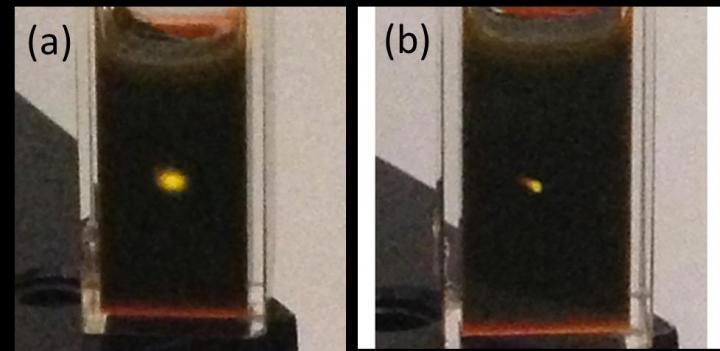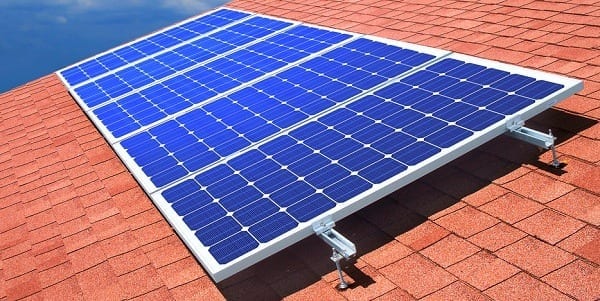
CREDIT
Zhiyuan Huang, UC Riverside.
UC Riverside researchers find a way to use the infrared region of the sun’s spectrum to make solar cells more efficient
When it comes to installing solar cells, labor cost and the cost of the land to house them constitute the bulk of the expense. The solar cells — made often of silicon or cadmium telluride — rarely cost more than 20 percent of the total cost. Solar energy could be made cheaper if less land had to be purchased to accommodate solar panels, best achieved if each solar cell could be coaxed to generate more power.
A huge gain in this direction has now been made by a team of chemists at the University of California, Riverside that has found an ingenious way to make solar energy conversion more efficient. The researchers report in Nano Letters that by combining inorganic semiconductor nanocrystals with organic molecules, they have succeeded in “upconverting” photons in the visible and near-infrared regions of the solar spectrum.
“The infrared region of the solar spectrum passes right through the photovoltaic materials that make up today’s solar cells,” explained Christopher Bardeen, a professor of chemistry. The research was a collaborative effort between him and Ming Lee Tang, an assistant professor of chemistry. “This is energy lost, no matter how good your solar cell. The hybrid material we have come up with first captures two infrared photons that would normally pass right through a solar cell without being converted to electricity, then adds their energies together to make one higher energy photon. This upconverted photon is readily absorbed by photovoltaic cells, generating electricity from light that normally would be wasted.”
Bardeen added that these materials are essentially “reshaping the solar spectrum” so that it better matches the photovoltaic materials used today in solar cells. The ability to utilize the infrared portion of the solar spectrum could boost solar photovoltaic efficiencies by 30 percent or more.
Read more: Reshaping the solar spectrum to turn light to electricity
The Latest on: Photovoltaic efficiencies
[google_news title=”” keyword=”Photovoltaic efficiencies” num_posts=”10″ blurb_length=”0″ show_thumb=”left”]
via Google News
The Latest on: Photovoltaic efficiencies
- JinkoSolar: Strong Operational Efficiency Makes It A Buyon April 26, 2024 at 10:41 pm
Jinko Solar leads in solar module manufacturing, contributing to China's economic growth and global influence through clean energy. See why JKS stock is buy rated.
- Energy Efficiency is Critical for a Sustainable Futureon April 26, 2024 at 9:00 am
Governments must prioritize energy efficiency and reduce energy waste to achieve clean energy security and combat climate change.
- Scientists develop material with potential to revolutionize solar panel efficency: 'Significant leap forward'on April 26, 2024 at 3:15 am
Researchers at Lehigh University have developed a solar panel that is nearly twice as efficient as most existing solar panels, using something called "quantum material." External quantum efficiency ...
- Solar Panel Recycling Market worth $931 million by 2029 - Exclusive Report by MarketsandMarkets™on April 26, 2024 at 3:14 am
The solar panel recycling market is poised for substantial growth in the foreseeable future, driven by a convergence of factors that underscore its critical importance in the transition to a more ...
- A shade closer to more efficient organic photovoltaicson April 24, 2024 at 10:00 am
Transparent solar cells will transform the look of infrastructure by enabling many more surfaces to become solar panels. Now, materials called non-fullerene acceptors that can intrinsically generate ...
- Researchers create nanostructures for efficient and sustainable degradation of pollutantson April 24, 2024 at 9:01 am
The need for sustainable and environment-friendly solutions has accelerated the global demand for green and renewable technologies. In this regard, semiconductor photocatalysts have emerged as an ...
- NREL updates interactive chart of solar cell efficiencyon April 24, 2024 at 8:44 am
The US National Renewable Energy Laboratory (NREL) has updated its research cell efficiency chart for a range of PV technologies.
- Photovoltaic Research Challenges: Overcoming Hurdles in Solar Technologyon April 24, 2024 at 7:44 am
Solar photovoltaic (PV) technology has evolved in the past few years, particularly in solar panels and systems. However, researchers and institutions are actively working to overcome limitations to ...
- Solar Energy Newson April 23, 2024 at 5:00 pm
Researchers Use Hawk Supercomputer and Lean Into Imperfection to Improve Solar Cell Efficiency Feb. 27, 2024 — Solar energy is one of the most promising, widely adopted renewable energy sources ...
- Harnessing solar energy for high-efficiency NH₃ productionon April 19, 2024 at 5:36 am
A technology that harnesses solar energy to produce high-efficiency ammonia (NH3) has been unveiled by a research team affiliated with UNIST.
via Bing News










